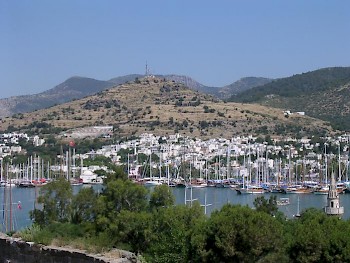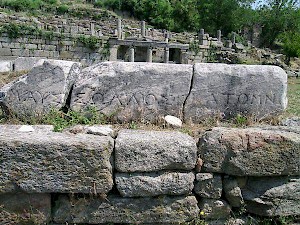Maussolus
Q296857Maussolus: satrap of Caria between 377 and 353, most famous member of the Hecatomnid dynasty.

Maussolus was the son of Hecatomnus, a Carian aristocrat who had in 392/391 obtained the satrapy of Caria from the Achaemenid king Artaxerxes II Mnemon. Although Hecatomnus probably had played with the thought of rebellion, he had always remained loyal, and there was no reason why Artaxerxes would not allow Hecatomnus' son to succeed his father.
We know hardly anything about Maussolus' youth, although he is known to have had a xenia with the Spartan king Agesilaus, which means that they were tied by mutual hospitality. Probably, Agesilaus had visited the young Carian nobleman when he was waging war in Asia Minor (396-394), but it is also possible that Maussolus visited Sparta.
When Maussolus became sole ruler in 377, the Achaemenid empire was involved in two major conflicts. In the southwest, Egypt had become independent, and Artaxerxes wanted it back; and in the north, the tribe of the Cadusians was dangerous. This gave the satraps of Asia Minor considerable freedom, and several Greek towns were afraid that the new satrap of Caria would expand his power to the west. In the year of Maussolus' accession, Athens concluded a new alliance, which was directed against Sparta, but also against "anyone making war against a signatory state", a remark that can only refer to attack from one of the satraps in the Persian empire.

Between 370 and 365, Maussolus returned the residence of Caria to Halicarnassus. (His father had always resided in Mylasa.) The city was fortified with modern walls, fit to withstand attacks by the recently invented catapults, and it received many new inhabitants. Its most famous building was the tomb that the satrap, like a Greek city founder, built for himself near the marketplace, which has become known as the Mausoleum and was reckoned among the seven wonders of the ancient world. It is very likely that Maussolus also moved and refounded other Greek cities, like Cnidus, Erythrae, and Priene.
In 367, the satrap of Hellespontine Phrygia, Ariobarzanes, revolted and a Persian army was sent against him; it was commanded by Maussolus and Autophradates of Lydia. They were able to isolate and besiege the rebel in either Assos or Adramyttum, but when the Spartan king Agesilaus arrived in Asia with a mercenary force (in 365), something strange happened: Agesilaus received money and presents from his friend, who gave up the siege. Of course the Spartan army could be dangerous, but it would have been sufficient to break off the siege and go away - there was no need to pay the enemy.
Perhaps, Maussolus bribed Agesilaus to stay away from Caria, or wanted to create a possibility to hire Spartan mercenaries in the future, or both. Whatever the reason, Maussolus briefly joined what the historian Diodorus of Sicily calls the "Revolt of the Satraps", which is perhaps too grand a name for a series of rebellions that continued for some time without really threatening the stability of the Persian empire. At various times, Ariobarzanes of Hellespontine Phrygia, Datames of Cappadocia, Maussolus of Caria, Orontes of Armenia, and Autophradates of Lydia were involved, and they received support from the pharaohs of Egypt, Nectanebo I (378-361), Teos (361-358), and Nectanebo II (358-341).

Briefly after 360, order had been restored, and when Artaxerxes III Ochus succeeded his father in the spring of 358, he had nothing to fear from the satraps. He choose to ignore the behavior of Maussolus, who had been among the last to join the rebellion and among the first to switch sides again. And although Maussolus had to accept a Persian garrison in Halicarnassus, he had acted more or less as an independent ruler and it comes as no surprise that he is several times called "king" in our sources.
And indeed, he acted as if he were a sovereign ruler, concluding treaties with towns like Phaselis and Cnossus, and appointing native Carians in offices that had hitherto been occupied by Iranians. That Maussolus regarded himself as some sort of national leader may perhaps also be inferred from his strict adherence to the ancient cults of his country. Although it was not unusual for the dynasts of what is now Turkey to sacrifice to the Persian supreme god Ahuramazda, or to venerate the Greek gods, none of these religious beliefs can be attested for Maussolus.
In 357, he helped the Athenian allies, who had revolted against their overlord. Some of these allies - Chios, Kos, Rhodes, and Byzantium - now became federates of Maussolus. It is not known why Maussolus supported them, but it is possible that king Artaxerxes III Ochus had ordered his satrap to entice the Greeks to revolt. The rebellion of the Athenian allies created great turmoil in the Aegean world and offered the Persian king an opportunity to launch an attack on Egypt (which ended in disaster).

The result was that Maussolus was satrap of Caria, but also an independent ruler who controlled several Greek towns and islands. (It is comparable to the Angevin rulers, who were independent as kings of the English and at the same time vassals of the French king as dukes of the Normans and Aquitanians.) The Greek towns were left more or less autonomous but were sometimes visited by inspectors. This model, which had been developed by the Persians ("eye of the king") and had also been used by the Athenians (episkopos), was copied by later rulers. In fact, Maussolus is part of the chain that connects the ancient Persian empire to the Hellenistic kingdoms.
Maussolus died in 353. He was succeeded by his sister (and wife) Artemisia, who invited the greatest Greek artists of the mid-fourth-century to the Carian capital to decorate the Mausoleum. The walls of Halicarnassus were strong enough to keep an army of rebellious Rhodians out, and Artemisia's rule was secure. However, she died after two years in power, and was succeeded by Idrieus and Ada, her brother and sister, who were, like Maussolus and Artemisia, husband and wife.